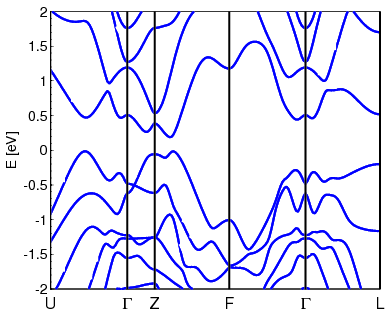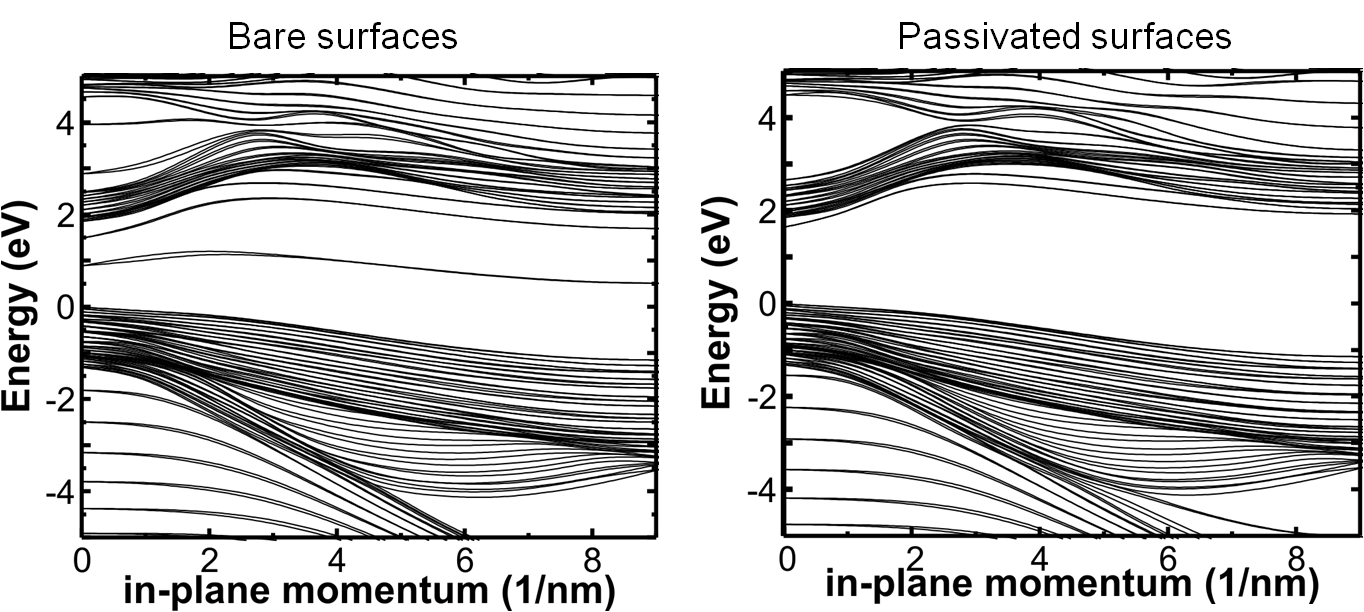Capabilities: Electronic Structure
Band structure calculations

Electronic band structure of bulk bismuth telluride, calculated with the 20-band sp3s*d5 tight-binding model.
NEMO5 is capable in solving the Schrödinger equation for all crystal structures mentioned above.
NEMO5 can handle any orthogonal tight-binding model in the two-center approximation. So far, the included tight-binding models are:
All the above models can include/exclude spin-orbit interaction.
The implemented general formula for tight-binding Hamilton parameters is taken from A. V. Podolskiy and P. Vogl (Phys. Rev. B 69, 233101 (2004)). This formula allows to include additional tight-binding models within about 5 minutes of coding.
Apart from tight-binding, NEMO5 also offers solving the Schrödinger equation in the effective mass approximation (see also below).Strain and surface passivation in nanodevices

Electronic band structure of a 4.3nm thick 111-grown GaAs quantum well. Left: the dangling bonds of the bare surfaces combine to surface states withing the band gap. Right: the Hydrogen passivation moves the surface states out of the band gap
Straight forward tight-binding calculations of semiconductor nandevices tend to produce dangling bonds in the center of the band gap. To avoid that, NEMO5 offers the option to passivate the surfaces with Hydrogen. Since NEMO5 mainly follows the scheme of S. Lee et al. (Phys. Rev. B 69, 045316 (2004)) these Hydrogen atoms are only included implicitly and do not increase the numerical load. In addition, NEMO5 generalizes the approach of S. Lee to allow for the passivation of arbitrary orbitals and surface directions.
NEMO5 also incorporates strain effects on the electronic band structure. For this purpose, the strain models of T. Boykin (Phys. Rev. B 66, 125207 (2002) and Phys. Rev. B 81, 125202 (2010)) have been fully included in NEMO5.
Self-consistent Poisson-Schrödinger calculations
In addition to all before mentioned effects, NEMO5 allows for the self-consistent solution of the Schrödinger and the Poisson equation with Dirichlet and Neumann boundary conditions (for Schottky barriers and Ohmic leads). Hereby, NEMO5 allows the user to decide whether to have the charge density calculated from the Schrödinger equation or from a semiclassical model.
Schrödinger-Poisson example taken from NEMO5-driven nanohub-tool 1dhetero. Blue: density of semiclassical model and of the Schrödinger equation. Red: Respective self-consistent potential profiles.
